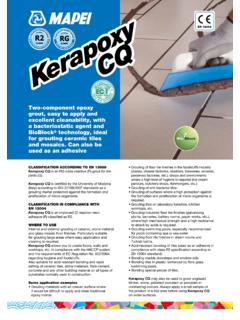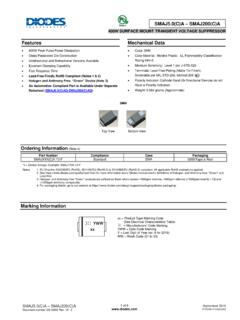Transcription of Framework for Constructing Scientifi c Explanations W
1 2. Framework for Constructing Scientific Explanations W. hat does it mean to construct a scientific explanation? What are the important features of scientific writing? How can you introduce those features to your students? Let's consider the following vignette from Mr. Lyon's eighth-grade classroom. Mr. Lyon's eighth-grade physical science class is examining what it means when a chemical reaction occurs, or more specifically, is discovering that a chemical reaction produces a new substance with different properties. Groups in his class dissolve a white powder in water to form a clear and transparent solution, then dissolve another white powder in water to form another clear and transparent solution. Student groups then pour the two clear liquids together and see a thick yellow solid that collects at the bottom of the test tube.
2 Mr. Lyon hears several students say, Cool, and Where did that stuff come from? Mr. Lyon then asks the groups to work together 18. to write a scientific explanation that answers the question: Did a new sub- stance form when the two solutions were poured together? He writes on the 19. board: Framework for A scientific explanation has three parts: Constructing Claim: a conclusion to a question or problem Scientific Evidence: scientific data that supports the claim Explanations Reasoning: a justification that links the evidence to the claim (use scientific principles to make that claim). He then tells the class to write their explanation and to place their explana- tion on an overhead transparency. After the students finish discussing and writing their explanation, Mr.
3 Lyon asks one of the groups to share their scientific explanation for class critique. Tonya, Shawn, and Miki volunteer to share their explanation. They place their explanation on the overhead and read it out loud: We think a new substance formed because a solid yellow material formed when we poured the two solutions together. Mr. Lyon asks Tonya, Shawn, and Miki, What is the claim in your explana- tion? Miki answers, Our claim is that a new substance formed. Mr. Lyon circles this part of their explanation and asks the class if they agree with this claim. All the student groups answer in unison: Yeah.. We think a new substance formed because a solid yellow formed when we poured the two solutions together. Mr. Lyon then asks Tonya, Shawn, and Miki, What is your evidence?
4 Shawn responds by saying, A yellow solid formed.. Mr. Lyon underlines this part of their explanation and asks the class, Do you agree with their evidence? Is there anything else they should add to their evidence? Several students raise their hands. We think a new substance formed because a solid yellow formed when we poured the two solutions together. Mr. Lyon calls on Owen. Owen says, They also need to add that before there wasn't a solid present in the solutions. This shows a change from a solution to solid. Also, the solutions started as clear. The yellow shows a change in color. Other students agree that both pieces of information are important evidence for their claim. Next, Mr. Lyon asks Tonya, Shawn, and Miki, What is your reasoning in your explanation?
5 Tonya responds, We forgot to include the reasoning.. Miki adds, You can tell since you circled the claim and underlined the evidence. There is nothing left to be the reasoning. Mr. Lyon then asks them 20 again, What can you add as the reasoning? Why does your evidence support your claim? Remember to make sure you include scientific principles. Miki Framework volunteers, The solid yellow substance has difference properties. Mr. Lyon for asks, Anything else? The group answers sheepishly, We don't think so.. Constructing Mr. Lyon then asks the class if they would add anything else. Several groups Scientific Explanations raise their hands. This scenario illustrates how a middle school teacher can support students in writing scientific Explanations . Mr. Lyon broke the complex task of writing a scientific explanation into three components ( , a claim, evidence, and reasoning), provided practice for students in writing Explanations , and encouraged peer review.
6 This chapter will help you understand how you can introduce scientific expla- nations to your students using a Framework we developed with grade 5 8 teachers to support students in Constructing scientific Explanations . Although many of the examples focus on students' written scientific Explanations , you can also use the Framework in classroom discussions or small group work when students are trying to make sense of scientific data. We describe the Framework first and then provide examples of student writing and videos to illustrate how to introduce the Framework to your students. Students' Understandings of Scientific Explanations When we ask students to construct a scientific explanation, the word explanation might have very different meanings to students than we might intend them to have.
7 The students' understanding of a scientific explanation does not necessarily match our expectations in terms of what we are hoping they will include in their writing and talk. When scientists create Explanations , they are trying to understand how or why different phenomena occur, such as global climate change. Furthermore, scien- tists use evidence to support and justify their claims. Students' intuitive understand- ings of scientific Explanations often do not include either of these ideas. Rather, students may view Explanations as just describing and summarizing. For example, in interviews with fifth-grade students, we asked them: What do you think it means for a scientist to create an explanation? The students' responses often focused on an exchange between people, such as if they tell somebody, like all the people, like in public that they learned something like new.
8 In other instances, students spoke about describing or observations, such as they try to explain um what they're doing, sort of like observing, describing what they see and what they're doing.. When asked about creating an explanation in science class, many students also talked about an exchange between people or observations. Unfortunately, almost half the students interviewed simply said that they did not know what it means to create a scientific explanation in school. Students' responses suggest that when we 21. ask them for a scientific explanation in class, they tend to be unclear of what exactly Framework to include in their writing, so we need to guide them in the process. It is important for to help them understand what it means to write a scientific explanation.
9 Constructing Scientific Explanations Framework for Constructing Scientific Explanations The instructional Framework for scientific explanation provides students with guide- lines for what to include in their science writing, oral presentations, and classroom discussions. The Framework can change students' understanding of what it means to create an explanation in science and in their science classroom. By making the implicit rules of science explicit, the Framework helps students see how to justify claims in science. We developed it for a certain type of science writing and talking: to encourage students to answer a question or problem using data given to them or that they collected themselves. To develop the Framework , we adapted Stephen Toulmin's (1958) model of argumentation that has been used by other science educators to support students in both writing (Bell & Linn, 2000; Berland & Reiser, 2009) and talk (Erduran, Simon, & Osborne, 2004; Jim nez-Aleixandre, Rodr guez, & Duschl, 2000).
10 Toulmin's argumentation model is also used in other content areas, such as social studies and language arts, and is frequently used in composition courses. Although we use Toulmin's basic structure, we adapt the language to be more accessible for students. Our scientific explanation Framework consists of four components: (1) claim, (2) evidence, (3) reasoning,1 and (4) rebuttal. Depending on the experience, understanding, and age of your students, you may want to start by introducing your students to the first three components of claim, evidence, and reasoning. When your students have more experience, you may then add the final component of the rebuttal, which is the most complex part of con- structing a scientific explanation. Figure displays the relationship between the claim, evidence, and reasoning.















